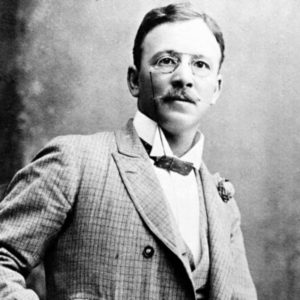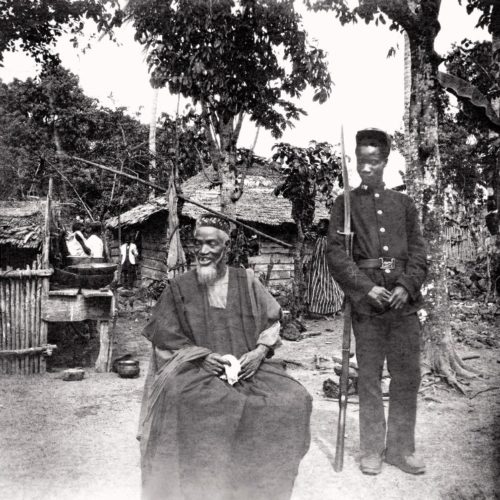When Diamonds Were a Jew’s Best Friend
The rise and fall of the Jewish diamond monopoly
The Legacy of Cecil Rhodes
DURING THE diamond rush that started in 1867 at Kimberley, Cape Colony, British colonialist and protégé of the Jewish Rothschild dynasty Cecil Rhodes got involved in the diamond business by renting water pumps to miners and buying up claims of small mining operations.
In 1871, Jewish Harry Isaacs left his slum in Whitechapel, UK to work in the area of Kimberley as a comedian and conjurer and was joined by his brother Barnett two years later. After changing their names to Harry and Barney Barnato, the bothers soon founded their own diamond company called the Barnato Diamond Mining Company that was focused on buying worked-out diamond mines and mining the abandoned blue ground heaps.
By 1888, the companies of the Bernato brothers and Rhodes had managed to purchase all other diamond mines, leaving only one another as competitors. Rhodes managed to purchase Barnato Diamond Mining Company for the then enormous amount of 4 million Pounds Sterling. The merger of both companies was called De Beers Consolidated Mines and became the sole owner of all diamond mining operations in the entire Cape Colony. Back then, this amounted to about 95% of the world’s diamond excavation.

No more than a year later, Rhodes used his monopoly to negotiate a strategic agreement with the London-based Diamond Syndicate, which agreed to regularly purchase a fixed quantity of diamonds at an agreed price. This allowed him to maintain the price of diamonds by curtailing supply in times of low demand, which was already put in practice during the trade slump of 1891–1892. The scarcity of polished diamonds during the 20th century was largely the consequence of this technique.
In 1890, Rhodes became Prime Minister of the Cape Colony, which was comprised of what is South Africa and Namibia today. He introduced various British imperial policies, such as the Glen Grey Act, to push Black people from their lands and make way for the development of the diamond industry. A Hut tax, which had such a major impact on the traditional way of life of Black locals that it sparked off two rebellions in 1898 in Sierra Leone, would be enforced after Rhodes’ death and would continue the process of Black relocation and disenfranchisement that Rhodes had set in motion.

Cecil Rhodes died in 1902. That same year, a competitive mine named the Cullinan Mine was discovered, however its owner refused to join the De Beers cartel. Jewish Ernest Oppenheimer moved to Kimberley to buy diamonds from the Cullinan Mine on behalf of the London based diamond brokers Dunkelsbuhlers & Co. Soon, production equaled all of the De Beers mines combined, as well as yielding the Cullinan Diamond, the largest diamond ever discovered. During WW1, De Beers managed to purchase the Cullinan Mine and therewith take its only major competitor out of the picture.
The Rise of the Oppenheimers
Meanwhile, Ernest Oppenheimer was appointed the local agent for the powerful London diamond syndicate and rose to the position of mayor of Kimberley. In 1917, Oppenheimer formed the Anglo-American Corporation of South Africa to exploit the east Witwatersrand goldfield.

After Oppenheimer had heard that diamonds were discovered in German South-West Africa (now Namibia) in 1908, he feared this would lead to a significant decrease of the price of diamonds. After WW1, he formed the Consolidated Diamond Mines of South West Africa in 1919 and gradually built himself a monopoly that equaled that of Rhodes in the Cape Colony.

Oppenheimer then offered Consolidated Diamond Mines of South West Africa to De Beers in exchange for a hefty amount of De Beers stock and a seat on the board of directors. As soon as the deal was finished, he and his family bought all the stock of De Beers they could find.
In 1929, Oppenheimer was elected as chairman and became the most powerful man in the diamond industry. Oppenheimer continued to apply the single channel marketing structure originally implemented by Rhodes and formed the Central Selling Organisation (CSO) by incorporating other major sellers and producers into De Beer’s syndicate. When pressuring companies to join their cartel didn’t work, De Beers used all sorts of illegal and immoral tactics to either destroy their opponents or make them change their minds. Similar techniques were used to keep the supply low and prices high.
When Oppenheimer died in 1957, his son Harry took over the role of chairman. He continued the strategies of his father and signed an agreement with the Soviets in 1959 to purchase their diamonds that were being mined in Yakutia. This was not his first major contribution to De Beers, though. In 1939 he initiated the marketing campaign for diamonds in the US that helped expand the market for diamonds to middle class Americans who had previously believed that diamonds were only for the extremely rich. In 1947 the famous slogan “A Diamond is Forever” was penned and the marketing machine had become mature. As a result of this marketing campaign, the demand for diamonds increased significantly and supply conveniently followed.

Harry Oppenheimer also contributed generously to the official philanthropies of the State of Israel. He personally directed that Israel receive the necessary diamond raw products from De Beers in order to establish itself as one of the world’s diamond polishing and exporting countries. In the 1970s and 1980s, he financed the anti-apartheid Progressive Federal Party, that later merged into the Democratic Alliance.
The Haredi Jews of Antwerp
Since the fifteenth century, when Antwerp diamond-cutter Lodewyk van Berken invented the scaif, diamond cutting became a traditional Jewish craft.
Antwerp, a Flemish port city of 500,000 people, has been the most important diamond-trading center in the world for quite a while. 80 to 90% of the world’s uncut diamonds, and half of its polished diamonds pass through Antwerp. In 2008, export figures alone amounted to a staggering amount of $15 billion. The city, which even has a trolley stop called Diamant (diamond), is home to 1,500 retail and wholesale diamond companies and four diamond exchanges (of 23 worldwide). One of the oldest, the Beurs voor Diamanthandel, was founded by Jews in 1904.
The Hasidic community of Antwerp consists of around 22,000 Jews. In the early 1900s, there were already about 700 Jewish diamond-cutters in Antwerp, many of whom had only just arrived from Central and Eastern Europe. The influx of rough diamonds from the Belgian colonies in Africa and the solidarity that existed within global Jewish community helped turn Antwerp into the main world center for the diamond industry. The industry had been Jewish owned ever since and until recently Yiddish was the most common language used in the Antwerp diamond industry. The Antwerp diamond industry as a whole is represented by a non-profit, public interest company called the Diamond High Council.

The Rise of the Israeli Diamond Industry
During the late 1930s, a handful of Jews in Palestine started receiving half-finished diamonds from Antwerp and so they founded their own polishing firms. In 1937, the “Palestine Diamond Club” was founded, being the first diamond trade organization in Palestine.
Today, Israel is the most important diamond-trading center besides Antwerp. In fact, in the 1970s, Harry Oppenheimer’s sponsorship allowed Israel to surpass Antwerp as the largest wholesale diamond center, accounting for more than 50% of all cut and polished gem diamonds. Diamonds were the only export in which Israel was more than a marginal supplier.
The slump in the industry from 1980 through 1982 surprised many Israeli firms that which only had speculative stockpiles. The result was a complete restructuring of the industry in FY 1984 and the creation of approximately 800 new and smaller manufacturing units. These small entities in mid-1986 concentrated exclusively on cutting, leaving the marketing to the 2,000-member Israel Diamond Exchange and the 300-member Israel Precious Stones and Diamonds Exchange.

The success of this revitalization can be seen in the trade figures for the industry. Between 1982 and 1986, net diamond exports rose from $905 million to $1.7 billion or 24% of total exports. Israeli citizen Lev Leviev, ranked 227th in the Forbes list, followed by Oppenheimer as the second richest diamond mogul with an estimated net value of $4.5 billion. He’s also a major sponsor of illegal Israeli settlements on Palestinian soil. Like the Antwerp diamond industry has its Diamond High Council, the Israeli diamond industry has its Israel Diamond Institute.
The Gujarati Takeover
Beginning in the 1960s, members of the Jain community in the area of Palanpur in Gujarat (known as Palanpuri Jains) began to migrate to Antwerp. The Palanpuri Jains are a historic “business community” in India that has traditionally engaged in trade and hence their first foray into Antwerp was one based on capital and prior experience on the polishing side of the diamond trade in India.
The Palanpuri Jains took advantage of two key factors to enter into the closed world of Antwerp’s diamond industry: they started to specialise in smaller, lower-value stones, and used the cheap labour and excellent skill of Surat’s diamond cutters and polishers to produce diamonds that had larger market potential. Thus, Gujaratis were able, as one trader put it: “to polish in rupees and sell in dollars”.
These two factors, along with others, such as initially buying from source and offering longer buying periods on credit in order to undercut the competition, enabled the Gujaratis to gain a foothold in Antwerp. This was further facilitated with the adoption of English as the international language of diamonds, although De Beers’ control of supply and demand managed to keep the Gujaratis in check.
Meanwhile, De Beers’ market manipulation was under legal scrutiny. By the end of the 20th century, too many new mines were being discovered and the demand could not keep up with the supply. With De Beers stockpiling nearly four billion dollars worth of rough diamonds, the US Department of Justice had charged De Beers with violating US antitrust at last.
While they managed to settle the antitrust law suit for a mere $295 million, it forced De Beers to reduce their stockpiles by making diamonds increasingly available to the Gujarati community. This allowed the Palanpuri Jains to outcompete the Haredi Jews in no time, which further opened up the market for independent producers like Petra Diamonds and the Katiawadi Patels.
The Katiawadi Patels were once agricultural laborers who moved to Gurjarat’s diamond polishing centre Surat, in order to escape drought. They started off as cutters and polishers, but quickly moved up the ranks and over time accumulated enough capital to open their own factories. They were able to use their contacts with Palanpuri Jains in order to first establish themselves in Antwerp. Once they did, they rapidly expanded and now rival the Jain Gujarati traders there.
Although the Patels did not arrive with the same level of financial capital as the Jains, their control of diamond polishing in Surat means that their climb within the industry is secure, and indeed will continue to grow with time. Currently, most factory owners and managers in Surat are Patel, with workers now coming from other states. In contrast to the Jains, whose sons have more business opportunities available to them, the sons of the Patels, who rely more heavily on diamonds, continue to enter into the diamond business in large numbers, starting from a young age to visit their fathers’ offices to learn the trade.
In the latest elections to the Antwerp World Diamond Centre in 2012, five out of the six representatives elected to the board were Gujarati. In 2014, a Gujarati businessman was nominated vice president. In their home region Gujarat, the diamond industry currently employs around 500,000 people. “It’s estimated that 9 out of 10 diamonds are polished in India, so in that sense it has already supplanted Belgium and Israel as the key diamond cutting centres,” says Johan Dippenaar, CEO of Petra Diamonds.
Blood Diamonds
Whereas 80% to 90% of all rough diamonds still passed through De Beers in the late 1980s, the American antitrust law suit and the subsequent rise of the Gujarati diamond empire allowed for market supply and demand dynamics, not the De Beers monopoly, to control diamond prices. During the early 2000s, countries like Australia, Canada and Russia started by-passing the DeBeers channel.
De Beers responded with campaigns (that received strong support from Jewish-dominated Hollywood) against buying “conflict” or “blood” diamonds. Rap stars, movie stars and articles in cyberspace have been very active warning us against these stones, so no trendy American liberal would would want to be caught buying such a diamond. These campaigns insist that anyone buying diamond jewelry must be careful to select only those diamonds certified by the accepted legal Kimberley Process Certification Scheme or KPCS. This scheme supposedly prevents earnings from rough diamonds going to monstrous regimes or rebel armies in West Africa, which have been characterized by rape, mutilations, displacement, and outright slaughter for more than a decade.

Few people realize, however, that the concept of “blood” diamonds is nothing but another marketing ploy by the De Beers syndicate. The KPCS was created for no other reason but preventing West African diamonds from flooding the market and pulling down the prices of raw diamonds and decreasing the market share of the growing competition De Beers faces. Besides, most diamonds could apply for the term “blood” diamonds if you consider the fact that the majority of rough diamonds are mined by means of slave laborers who are controlled by De Beers’ private armies.
An Uncertain Future
As “Blood Diamond” campaign was too late to do anything about the decline of the De Beers empire. Its market share is currently estimated to be only around 35–40%. The Oppenheimer family ended its 85-year reign of the De Beers empire in 2012 when Nicky sold his 40% stake to mining conglomerate Anglo American for $5.1 billion in cash. He didn’t leave the company a poor man though, as he is currently ranked 201rd of the Forbes list with a new net worth estimated at $6.7 billion while retaining an estimated 1.8% stake in the company.
Petra Diamonds has a record of turning De Beers’ poorly run South African mines into financial successes and managed to acquire no less than five mines in South Africa and Tanzania from De Beers, including the Williamson Mine, the Cullinan diamond mine and the Finsch Mine.
Although its grip on the industry has loosened, De Beers’ executives seem comfortable with the status quo. “We are no longer the ‘custodian’ of the diamond industry,” De Beers CEO Philippe Mellier told journalists at a media briefing in Tel Aviv in June. “We are, by value, the biggest seller of rough diamonds with more than one-third of global production. But we are no longer the overwhelming force.”
Anglo American, which Nicky’s grandfather founded, now controls 85% of De Beers, with the government of Botswana owing the remaining 15%. The De Beers center for rough stone sorting, or aggregation operations is currently being relocated from London to Botswana after 80 years of operation.
Botswana and De Beers in September 2011 signed a 10-year deal to move its rough stone sorting and trading division from London to Gaborone. Since it started mining diamonds in the early 1970s, Debswana — a company equally owned by Botswana’s government and De Beers — has been selling its diamonds exclusively to De Beers, who in turn shipped the diamonds to London for sale to customers.
Under the deal, Botswana will for the first time directly sell 10 percent of gemstones manufactured locally while De Beers will also increase the value of diamonds it makes available to manufacturing companies in the country to $800 million a year from the current $550 million.
Meanwhile, growing competition from corporations based in China along with Internet trading continue to further erode what had been a very profitable Jewish monopoly for decades. Does this mean the end of the Jewish monopoly of the diamond industry? Will they find a way to take back control of the market from the Gujaratis? Will they manage to re-centralize the currently decentralizing market? If history teaches us anything, it’s to never underestimate a Jew.
* * *
Source: Medium







Diamonds, like gold, have always held attraction for lesser intellects; witness the “bling” bedecked Negro. I once made the rounds with a southern Mississippi gentleman who had displays set up in the region’s local convenience stores. These displays were designed to sell what he called “golden garbage.” When I asked him why he used that particular title for his wares, he replied, “You know, it’s that junk jewelry we sell to niggers.” Diamonds are nothing more than a scam originally sold to royalty with money to burn on monstrous palaces and castles. Later with the help of mass marketing, using the concept of “love” as a focus, diamonds soon became a prized possession of women. However, these stones are actually bought by unsuspecting goy males befuddled by emotions that never… Read more »
hehehe…100% agree. Diamonds are a piece of shit proposition. Go into debt to demonstrate your dedication to a female. Do it for love. Be a slave. I have studied marketing and propaganda for a decade or more and recognize this pretty quick. It’s lame crap for people who go crazy for mini poodles in sweaters. Or as my mom calls it, ‘chazerai’. As for gold…ancient Egypt was the first place to use it as money / currency and I don’t think gold is a bad standard for economic trade and it had enough allure to pave California and Alaska… But I’m leaning towards investment in copper because it actually has industrial uses, is in constant demand and has steadily gone up in value. If I were to ever give a… Read more »
The diamond industry is largely a scam, as would be expected from an enterprise dominated by jews. I remember driving in Namibia several years ago and seeing fences that ran for hundreds of miles enclosing wide open spaces owned by De Beers or some other company which contained diamonds just lying on the surface as some locals told me. There isn’t now, and never was, any shortage of diamonds. They can be found in all sorts of places where there is igneous rock. Diamonds should only cost a fraction of what is charged to those who buy them.